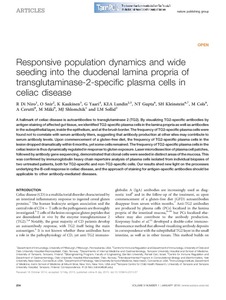Responsive population dynamics and wide seeding into the duodenal lamina propria of transglutaminase-2-specific plasma cells in celiac disease
Di Niro, R; Kaukinen, K; Yaari, G; Lundin, KEA; Grupta, NT; Kleinstein, SH; Cols, M; Cerrutti, A; Mäki, M; Shlomchik, MJ; Sollid, LM (2016)
Di Niro, R
Kaukinen, K
Yaari, G
Lundin, KEA
Grupta, NT
Kleinstein, SH
Cols, M
Cerrutti, A
Mäki, M
Shlomchik, MJ
Sollid, LM
2016
Mucosal Immunology 9 1
254-264
Lääketieteen yksikkö - School of Medicine
Julkaisun pysyvä osoite on
https://urn.fi/URN:NBN:fi:uta-201610102398
https://urn.fi/URN:NBN:fi:uta-201610102398
Tiivistelmä
A hallmark of celiac disease is autoantibodies to transglutaminase 2 (TG2). By visualizing TG2-specific antibodies by antigen staining of affected gut tissue, we identified TG2-specific plasma cells in the lamina propria as well as antibodies in the subepithelial layer, inside the epithelium, and at the brush border. The frequency of TG2-specific plasma cells were found not to correlate with serum antibody titers, suggesting that antibody production at other sites may contribute to serum antibody levels. Upon commencement of a gluten-free diet, the frequency of TG2-specific plasma cells in the lesion dropped dramatically within 6 months, yet some cells remained. The frequency of TG2-specific plasma cells in the celiac lesion is thus dynamically regulated in response to gluten exposure. Laser microdissection of plasma cell patches, followed by antibody gene sequencing, demonstrated that clonal cells were seeded in distinct areas of the mucosa. This was confirmed by immunoglobulin heavy chain repertoire analysis of plasma cells isolated from individual biopsies of two untreated patients, both for TG2-specific and non-TG2-specific cells. Our results shed new light on the processes underlying the B-cell response in celiac disease, and the approach of staining for antigen-specific antibodies should be applicable to other antibody-mediated diseases.
Kokoelmat
- Artikkelit [6140]
